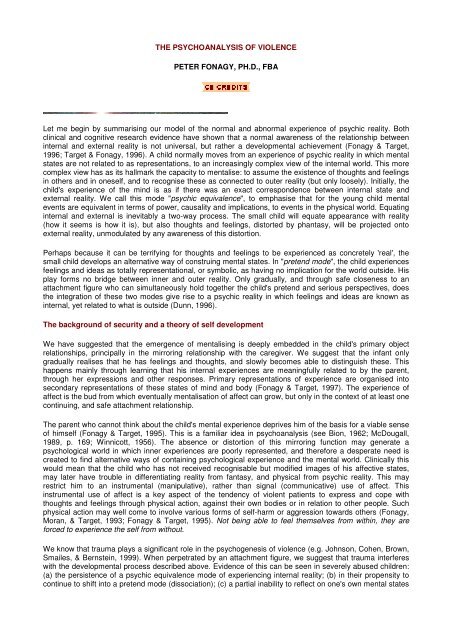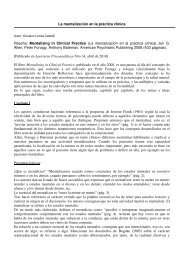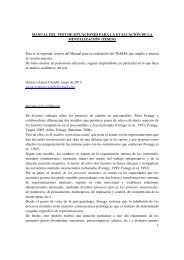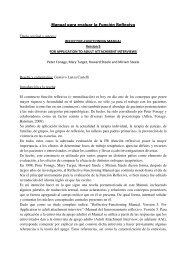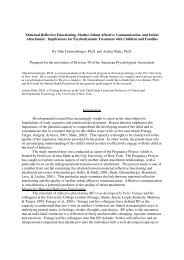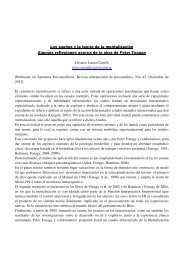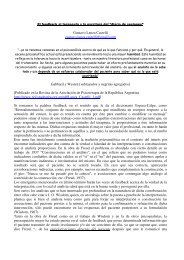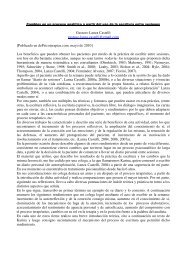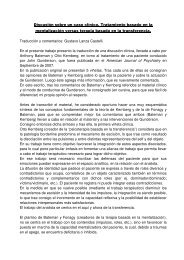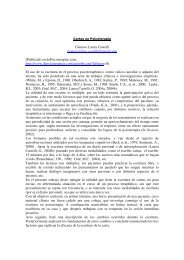THE PSYCHOANALYSIS OF VIOLENCE PETER FONAGY, PH.D ...
THE PSYCHOANALYSIS OF VIOLENCE PETER FONAGY, PH.D ...
THE PSYCHOANALYSIS OF VIOLENCE PETER FONAGY, PH.D ...
You also want an ePaper? Increase the reach of your titles
YUMPU automatically turns print PDFs into web optimized ePapers that Google loves.
<strong>THE</strong> <strong>PSYCHOANALYSIS</strong> <strong>OF</strong> <strong>VIOLENCE</strong><br />
<strong>PETER</strong> <strong>FONAGY</strong>, <strong>PH</strong>.D., FBA<br />
Let me begin by summarising our model of the normal and abnormal experience of psychic reality. Both<br />
clinical and cognitive research evidence have shown that a normal awareness of the relationship between<br />
internal and external reality is not universal, but rather a developmental achievement (Fonagy & Target,<br />
1996; Target & Fonagy, 1996). A child normally moves from an experience of psychic reality in which mental<br />
states are not related to as representations, to an increasingly complex view of the internal world. This more<br />
complex view has as its hallmark the capacity to mentalise: to assume the existence of thoughts and feelings<br />
in others and in oneself, and to recognise these as connected to outer reality (but only loosely). Initially, the<br />
child's experience of the mind is as if there was an exact correspondence between internal state and<br />
external reality. We call this mode "psychic equivalence", to emphasise that for the young child mental<br />
events are equivalent in terms of power, causality and implications, to events in the physical world. Equating<br />
internal and external is inevitably a two-way process. The small child will equate appearance with reality<br />
(how it seems is how it is), but also thoughts and feelings, distorted by phantasy, will be projected onto<br />
external reality, unmodulated by any awareness of this distortion.<br />
Perhaps because it can be terrifying for thoughts and feelings to be experienced as concretely 'real', the<br />
small child develops an alternative way of construing mental states. In "pretend mode", the child experiences<br />
feelings and ideas as totally representational, or symbolic, as having no implication for the world outside. His<br />
play forms no bridge between inner and outer reality. Only gradually, and through safe closeness to an<br />
attachment figure who can simultaneously hold together the child's pretend and serious perspectives, does<br />
the integration of these two modes give rise to a psychic reality in which feelings and ideas are known as<br />
internal, yet related to what is outside (Dunn, 1996).<br />
The background of security and a theory of self development<br />
We have suggested that the emergence of mentalising is deeply embedded in the child's primary object<br />
relationships, principally in the mirroring relationship with the caregiver. We suggest that the infant only<br />
gradually realises that he has feelings and thoughts, and slowly becomes able to distinguish these. This<br />
happens mainly through learning that his internal experiences are meaningfully related to by the parent,<br />
through her expressions and other responses. Primary representations of experience are organised into<br />
secondary representations of these states of mind and body (Fonagy & Target, 1997). The experience of<br />
affect is the bud from which eventually mentalisation of affect can grow, but only in the context of at least one<br />
continuing, and safe attachment relationship.<br />
The parent who cannot think about the child's mental experience deprives him of the basis for a viable sense<br />
of himself (Fonagy & Target, 1995). This is a familiar idea in psychoanalysis (see Bion, 1962; McDougall,<br />
1989, p. 169; Winnicott, 1956). The absence or distortion of this mirroring function may generate a<br />
psychological world in which inner experiences are poorly represented, and therefore a desperate need is<br />
created to find alternative ways of containing psychological experience and the mental world. Clinically this<br />
would mean that the child who has not received recognisable but modified images of his affective states,<br />
may later have trouble in differentiating reality from fantasy, and physical from psychic reality. This may<br />
restrict him to an instrumental (manipulative), rather than signal (communicative) use of affect. This<br />
instrumental use of affect is a key aspect of the tendency of violent patients to express and cope with<br />
thoughts and feelings through physical action, against their own bodies or in relation to other people. Such<br />
physical action may well come to involve various forms of self-harm or aggression towards others (Fonagy,<br />
Moran, & Target, 1993; Fonagy & Target, 1995). Not being able to feel themselves from within, they are<br />
forced to experience the self from without.<br />
We know that trauma plays a significant role in the psychogenesis of violence (e.g. Johnson, Cohen, Brown,<br />
Smailes, & Bernstein, 1999). When perpetrated by an attachment figure, we suggest that trauma interferes<br />
with the developmental process described above. Evidence of this can be seen in severely abused children:<br />
(a) the persistence of a psychic equivalence mode of experiencing internal reality; (b) in their propensity to<br />
continue to shift into a pretend mode (dissociation); (c) a partial inability to reflect on one's own mental states
and those of one's objects. We are suggesting that these ways of thinking persist into adulthood, and play a<br />
vital role in acts of enraged violence. I would now like to elaborate these ideas in the context of a<br />
psychoanalytic case report. I hasten to add that my purpose in doing this is not to recommend that intensive<br />
psychotherapy should be used with individuals such as my patient. Rather, I think the treatment highlights<br />
the value of psychoanalytic treatment as an important observational tool in our quest to understand the deep<br />
psychological mechanisms of the horrifying problems of violence that surround us.<br />
A psychoanalytic treatment of a murderer<br />
Henrietta, a young woman, referred herself to a forensic psychiatrist colleague for counselling. Strangely, the<br />
referral on to me mentioned nothing about a forensic history, but described repeated suicide attempts,<br />
unstable but intense relationships, and abuse of her medication. The referral did not prepare me adequately,<br />
however, for the paranoid, almost psychotic but in fact dissociated, episodes with hallucinations and some<br />
thought disorder, which were to be so striking in my work with her.<br />
There are two facts that make Henrietta's history unusual. The first is that she was a murderer; not of her<br />
internal objects, her self-representation, her thinking and feeling or other parts of her and her object's mind,<br />
although she is undoubtedly guilty of all these - but of her boyfriend. She stabbed him in the course of a<br />
violent quarrel. She pleaded self-defence and that the stabbing was accidental. She was charged with<br />
manslaughter and was freed with a suspended sentence. About four years into the analysis she confessed<br />
to me that the stabbing had not in fact been an accident. While not premeditated, it had certainly been<br />
intentional. She had felt driven by violent, blinding rage. By that time, four years into the therapy, I was<br />
familiar with Henrietta's violent tendencies and her vicious explosive attacks of rage. I was not really<br />
surprised by her revelation.<br />
The second fact was her experience of abuse. She described having first been sexually abused by her<br />
alcoholic father, then as a teenager by a teacher in her boarding school. Both experiences included<br />
intercourse. Her father also beat Henrietta for various misdemeanours at least once a week, and more<br />
severely, usually for "answering back", at least once a month. The abuse by her father remained a secret<br />
between them until his death shortly before the start of her treatment. The relationship with the teacher<br />
became public, and the man concerned was dismissed.<br />
Why would someone like Henrietta come into therapy? She seemed never to have had an understanding<br />
relationship. She said she wanted to get help with the terrifying dreams which had started with the death of<br />
her father. She came to the first interview in a strident mood, demanding a brief period of counselling. She<br />
did not know that I was a psychoanalyst and, on noticing the couch some time into the interview, she said<br />
"So, this is where you fuck your patients?". A feeling of fear washed over me. Rather than reacting directly to<br />
her combative intrusive manner, I was aware of the vulnerability and enormous anxiety behind her need to<br />
strike out and hurt. I said, aiming to be reassuring, "You must feel quite brave that you dared to come and<br />
see me". She said, continuing her contemptuous tone, "You shrinks are abusers. It's just a power trip". I said,<br />
now more confident of my countertransference response, "I think it is your own power to destroy and abuse<br />
that frightens you about therapy. You feel much more confident about being able to cope with me". She<br />
stopped short and asked me what I meant by "therapy".<br />
She arrived on time to the session, sat in a chair and said she felt upset, and looked at me challengingly<br />
without speaking further. I said "I don't understand. You need to tell me what upset is for you at the moment".<br />
She said that she had had another dream about her father which had upset her. In the dream, he had asked<br />
her to put her head up his backside and she did not want to do it. She was ready to follow through with a<br />
string of obscene images depicting the sexual life between her father and herself. I interrupted "I think you<br />
are upset because you are frightened that I will make you bury your head in messy thoughts here". She<br />
stopped in her tracks, told me in a rapid sequence I could hardly follow, that she was lost, that her mother<br />
didn't understand, she wasn't trying to hurt anybody, that the death was an accident, that she tried to<br />
resuscitate him, to give him the kiss of life, but failed, and now I was trying to kill her. There was a gradual<br />
acceleration of tempo and intensification of affect. By the end I was in the room with an apparently angry, yet<br />
basically terrified person. It was unclear what these feelings were about. She seemed terrified by violence,<br />
her own or mine. She expected to be killed by a raging jealous object or to kill an invading, threatening one. I<br />
said, trying to calm her by stepping outside the fray: "It seems that you feel driven by a terror that you might<br />
lose me in this violence. You feel you have to constantly resuscitate me, to breathe life into me just to keep<br />
me alive for yourself". She was silent. Eventually she responded, somewhat more calmly, that she was<br />
frightened of being a person. She preferred being empty; people only attacked you if they knew you were<br />
somebody. I said, "I agree. I think you feel safer with me when you feel empty. It feels even safer if you feel
you have emptied me too". Her terror that I might kill her and the even greater fear that she might kill me,<br />
intentionally or accidentally, overrode all other concerns.<br />
This brief vignette raises several issues. I did not presume to know what 'upset' meant for Henrietta at this<br />
time. Most patients would have been aware that their therapist was not going to know what was upsetting<br />
them, but for a patient working in psychic equivalence mode, the therapist already knows what she knows<br />
(perhaps better than she does) and does not need to be told. After my intervention, Henrietta immediately<br />
shifted into pretend mode, starting to talk about the dream images. Unlike the situation with a neurotic<br />
patient, for whom the exploration of a sexual fantasy might be therapeutic, for a patient like Henrietta it<br />
seemed vital to interrupt her retreat into something that she represented as unreal. The therapist's task in<br />
such a situation is to find something felt as real within that unreal image, which may be deeply obscure. I<br />
therefore focused on the anxiety about the confusion which having to talk about her thoughts and feelings<br />
evidently confronted her with. That in itself provoked more anxiety in the patient than it contained. Suddenly,<br />
the fantasies became real: she shifted into a psychic equivalence mode and seemed almost to feel that her<br />
life was in danger. This panic escalated until somebody else contained it. Somebody was going to get killed.<br />
The aim of this sort of cathartic outburst is not, I suggest, a wish to be contained, nor (certainly) a wish to<br />
work through an experience, but rather an emptying of the self which quite consciously feels like pre-empting<br />
an imminent attack. In such a situation, the countertransference response is often a sense of emptiness on<br />
the part of the therapist; this is not seen as the result of an intentional destructive attack by the patient on the<br />
therapist's thinking, but rather as an attempt to relieve anxiety by reducing both people to an equally<br />
unthinking state.<br />
Henriett'a thoughts did not feel owned by her mind, but rather were experienced almost as if spoken and<br />
thus made externally real. We see this as one consequence of equating inner experience with outer reality. It<br />
took me some time to realise that in my conversations with her there was often a third presence: a voice<br />
inside her head, someone she felt was her, but not her at the same time, an alien aspect of her often<br />
dissociated state. Her thoughts seemed to possess a concreteness and immediacy that was difficult to<br />
appreciate fully. Fleeting ideas or images were experienced as disembodied voices, sometimes friendly but<br />
mostly persecutory and vicious. While clearly not the same as hallucinations in a schizophrenic patient, nor<br />
were her thoughts felt to be coming from her own mind. Her verbalisations at these times were responses to<br />
what she 'heard' as much as they were responses to her dialogue with me. This posed an interesting<br />
challenge for my work in the transference. Eventually, I began to address this voice more directly.<br />
For example, one session she was upset, she buried her head in the pillow and started to sob violently; "I am<br />
so confused. I feel so bad. I am told I am fine, but I feel hopeless. Please tell me what is wrong with me". I<br />
replied with the intention to enter into her mental world, but at the same time to insert the analyst's voice as<br />
another perspective which could eventually become therapeutic. "You feel that because I ask you to come<br />
here for only 50 minutes on a particular day, so I can't possibly understand what your needs really are. I think<br />
you have a voice inside your head telling you 'you are fine'. And it sometimes sounds like my voice". She<br />
calmed down a bit and then she seemed to suffer something like an allergic response to contact with me.<br />
She suddenly said, as if unaware of the contradictions, "I don't need help. I am fine. I am sick. I want to throw<br />
up". Then a pause, "I want to throw up when people get too close. You get taken over. You must understand<br />
me. You don't understand me. Do you understand me?". I said, trying to identify the source of anxiety, "You<br />
are terrified of what I do understand. It must be so sickening that I have to throw you out". She said, still<br />
sobbing, "It's the sex. It's so wrong. I am so frightened you might misunderstand. I am trying so hard to make<br />
something happen this time". I said, regarding the reference to sex as defensive, aiming to distract us from<br />
the immediate source of her anxiety: "You hope for something good to happen here, but you are also<br />
frightened because you hear a voice telling you to spoil it by confusing and misleading me".<br />
The understanding that I had to hold on to over these early years was that alongside her craving for anything<br />
which might give a sense of order to her psychic chaos, she desperately fought the truth of any idea, not for<br />
its specific contents, but because of the intolerable sickness which the closeness of two human minds<br />
engendered. There was something that felt sickening and disgusting about genuine feelings and ideas; there<br />
was an abhorrence of communication and reflection. She had tried to repudiate her capacity to conceive of<br />
mental states, in herself and in me, leaving her with rigid, schematic representations.<br />
Therapy was an obscene seduction because thinking about mental states was an incestuous act,<br />
experienced as the intrusion of an object into a space far too small to contain it. Her adaptation to trauma<br />
entailed the disavowal of conceiving of feelings and intentions, in herself and in all others close to her. The<br />
primary thoroughfare for sharing psychic reality, symbolic thought, was blocked. The transference could not<br />
be referred to as an 'as if' experience; at this stage perhaps, I needed to work partly within the frame of<br />
reference of psychic equivalence, notwithstanding my immense countertransference resistance against
entering that frame of reference with somebody whose thoughts were terrifyingly violent and confused. It was<br />
my task to make the capacity for the representation of her internal states safe. This is what a parent needs to<br />
be able to do with a small child, but to identify with the perspective of a violent, uncontrolled adult is far more<br />
threatening and disturbing than doing the same with a child, even a child with similar violent feelings.<br />
Ideally, the parent accepts the child's experience when the child is in a mode of psychic equivalence, rarely<br />
confronts it directly, but at the same time behaves in a way that implies that the parent does not have the<br />
same experience. A small child may be too frightened to sleep because the dressing gown hanging behind<br />
the door seems to be a man waiting to jump out when he shuts his eyes. This is experienced as real to the<br />
child at those times, and the feeling of terror is correspondingly compelling. The parent does not simply tell<br />
the child that the dressing gown is not a man, or that it is silly to be frightened, but removes the dressing<br />
gown in a way that recognises the reality of the frightening idea, but without showing fear, instead<br />
communicating safety . Thus, the parent both enters into and provides the possibility of distance from the<br />
child's perception, introducing a different perspective. This is parallel to the introduction of alternative<br />
perspectives through playing and pretending with the child, but this time in a 'serious' mode.<br />
This is what the therapist is engaged in with violent patients. I respected the reality of her terror of closeness,<br />
but in doing so also introduced the idea that this was a belief rather than reality. No technical innovation is<br />
implied here. This is the very ordinary thing that psychotherapists do.<br />
In Henrietta's sessions the affect was intense. The terror and the distress were real: a desperate hunger for<br />
understanding only matched by her desire to empty her mind of all contents. The counter-transference was<br />
brimming with discomfort and confusion. She acted dangerously, threatened to take her life regularly and got<br />
into violent quarrels with both friends and strangers for which I was made to feel culpable. She frightened me<br />
with the threat of litigation for negligence and gave me a letter of complaint which she had drafted for my<br />
professional association where my "incompetence" was carefully documented: any change of appointment,<br />
cancellation, lateness, confusion about times, misremembering of names - all were listed and dated. I was<br />
criticised for speaking and then ridiculed for my silences. At other times I was made to feel her savior. The<br />
fluidity of her psychic reality meant that much of the time I could not know what I was doing, beyond the<br />
basic effort to appreciate what her psychic equivalence exposed me to, and then to attempt to communicate<br />
that awareness to her. At other times, of course, she was quite dissociated, lost in silences that carried no<br />
meaning. Perhaps a key part of dissociation as a phenomenon is the re-emergence of the pretend mode, in<br />
which the very young child fully enters a separate psychic world, and cannot simultaneously maintain contact<br />
with ordinary reality.<br />
The alien self<br />
I now want to talk more specifically about a concept related to psychic reality: that of the sense of self. The<br />
lack of a stable sense of self is a central difficulty for violent patients. The symbolic representation of mental<br />
states can be seen as an essential prerequisite of a sense of identity. The patient lacks an authentic, organic<br />
self-image built around internalised representations of self-states. The absence or weakness of such a selfimage<br />
leaves the child, and later the adult, with affect which remains unlabelled and confusing. This will<br />
create a desperation for meaning, and a willingness to take in reflections from the other which do not map<br />
onto anything within the child's own experience. It will lead to the internalisation of representations of the<br />
parent's state rather than of a usable version of the child's own experience. This creates what we term an<br />
alien experience within the self: ideas or feelings are experienced which do not seem to belong to the self.<br />
The alien self destroys the sense of coherence of self or identity, which can only be restored by constant and<br />
intense projection. Clinically, the projection is not motivated by guilt, but by the need to reestablish the<br />
continuity of self experience.<br />
Let me illustrate this with another example. With Henrietta, dreams were like small oases in a cruel desert of<br />
enactments and manipulations which all but destroyed the possibility of reflectiveness. The dreams were<br />
vivid and varied, but I gradually noticed a consistent theme. There was always something within something<br />
else - and the thing within was absolutely dependent - almost parasitic - upon the thing without. For example,<br />
there was a dream about a lizard with a fly buzzing inside its stomach. Another about a skyscraper which<br />
had a yard with a semi-detached (little) house with its own tiny yard. She had a particularly unpleasant<br />
recurrent dream of a beetle having created a larva which was growing inside her brain.<br />
Henrietta represented an experiential inner world which depicted a self which, in its turn, contained a self. I<br />
began to understand her problem as one of a self-representation distorted by containing within it a<br />
representation of the other. This representation of the other would be internalised in early infancy when the
mother's reflective function at least partially failed the infant. The infant, trying to find herself in the mother's<br />
mind may find, as Winnicott (1967, p.32) so accurately put it, the mother instead. The image of the mother<br />
would come to colonise the self.<br />
The residue of maternal non-responsiveness (Tronick & Gianino, 1986), this alien other, probably exists in<br />
seed form in all our self-representations. It comes into its own when later trauma calls it forth as part of a<br />
defensive manoeuvre: identifying with the state of mind of the abuser, in an attempt to restore a feeling of<br />
control. The alien other within the self, once abuse has given it form and shape, can be unmasked by the<br />
absence of reflective function. Normally, parts of the self-representation which are not rooted in the<br />
internalised mirroring of self-states are nevertheless integrated into a singular, coherent self-structure by the<br />
capacity for mentalisation. This process preconsciously works to lend a coherence and psychological<br />
meaning to one's life, one's actions, and our sense of ourselves. Henrietta lacked the capacity to understand<br />
the experience of the buzzing fly inside her self-representation, or to metabolise the feelings and ideas that<br />
she experienced as having been placed there, like a larva in her brain. Henrietta could learn little about<br />
herself through interpretations of this kind, yet the mental language of my communications strengthened and<br />
enhanced her reflective capacities which was her only route to the recovery of the integrity of the self.<br />
Let me illustrate what I mean by elaborating on the two unusual 'facts' of Henrietta's life. First, Henrietta's<br />
experience of having been abused. Henrietta's mother, probably herself a 'survivor', had a prolonged<br />
postnatal depression after the birth of her second child when Henrietta was two. She withdrew almost<br />
completely from both Henrietta and Henrietta's father, and eventually left the family. This probably<br />
exacerbated his already considerable drug problems and he began to seek solace from at first cuddling, then<br />
rubbing against and finally vaginally and then anally penetrating his daughter. I suspect this happened when<br />
she was about seven and went on for at least four years. Henrietta recalls initially welcoming his attention<br />
(even encouraging it) and gradually, when "the pain" started, going blank and this helped him get inside her.<br />
She describes imagining herself as one of her lifeless dolls. The essential part of this description is the lack<br />
of attribution of mental states to the self and other representations. The strategy of inhibiting her mentalising,<br />
and thus creating a dissociated state, is critical. It was impossible for her to understand how her father could<br />
contemplate hurting her as part of what grew out of an act of affection. The disavowal of mental states was<br />
an adaptation. It distanced her from a mind with truly malevolent ideas about the fragile child. As she turned<br />
away from mental states in him, and in herself, she was forced to fall back on the non-reflective organisation<br />
within the self - the alien other.<br />
The alien other is not entirely a creation of trauma. It is an infantile structure internalised in place of, yet also<br />
as part of, the self. Henrietta's mother was incapable of satisfying her infant's essential need for reflecting her<br />
distress and nascent states of intentionality. Normally, the internalisation of the mother's mirroring becomes<br />
the core of the representation of the psychological self. Henrietta, neglected or unrecognised as a small<br />
child, internalised an image of absence or vacuousness as the representation of her state of distress. Not<br />
surprisingly, it was this state which was re-activated in moments of the acute distress of seduction. Not<br />
surprising, since it too was an experience of feeling unrecognised. Reflectiveness temporarily abandoned,<br />
the self-other boundary destroyed, the abusing father's cruelty was internalised into the alien selfrepresentation<br />
through a process which may be related to the mechanism whereby the victim identifies with<br />
the aggressor. Thus, the alien part of the self became torturing as well as vacuous. Her experience of abuse<br />
at boarding school, after the age of eleven, simply reinforced this deeply pathological self organisation. Her<br />
real, or what may be called constitutional, self was experienced as tiny in relation to the monstrous other (the<br />
tiny house in the back yard of the skyscraper). Yet, she also felt herself a monstrous lizard because this<br />
other, was also her self.<br />
Finding others to be a vehicle for this torturing part of her self-representation became a matter of life and<br />
death. Her experience of self coherence depended on finding someone willing to torture her. The teacher<br />
was perhaps the first. A line of severely sado-masochistic relationships testified to the fact that he was<br />
certainly not the last. The transference was a lived instance. In contrast to the 'role-responsiveness' model of<br />
transference-countertransference (Joseph, 1985; Sandler, 1976) where an aspect of the self-other<br />
relationship is externalised, a self-self transference evolved, where the therapist became a temporary home<br />
to the alien aspect of Henrietta's self-representation. These instances are pervasive for two reasons. First, as<br />
we have already seen, the normal binding of alien aspects of the self by mentalisation does not occur, and<br />
therefore aspects of the self-representation are more likely to be externalised. However, even more critically,<br />
once these experiences are created they are actually far more compelling for these individuals because they<br />
are experienced in a mode of psychic equivalence.<br />
Over its fourth year, her treatment began to take on a tragic quality and the dramatic outbursts had receded.<br />
She was functioning somewhat better but the sessions came to be dominated by expressions of bitterness.
Hatred for her father began to emerge, together with a genuine and deep dislike of me. The transference<br />
could now become sexualised and, at times, she explicitly asked me to molest her whilst she was angry with<br />
me. She came in one Thursday evening and recounted a particularly ghastly episode of allowing herself to<br />
be used and abused by "an old friend" who regularly visited her as his needs dictated. My mind was filled<br />
with bizarre and perverse associations. I said that I suspected that, for some reason, it was particularly<br />
important to feel that she could control me by exciting me or worrying me and I suspected that she had felt<br />
the same vital sense of control in relation to her "old friend".<br />
She responded that she hadn't been going to tell me but that she had had a dream about me where I had<br />
offered her my penis, suggesting that she should take it in her mouth. She was revolted by it because it was<br />
smelly and dirty. She was frightened because she knew I was going to beat her unless she submitted. She<br />
paused, waiting for me to say something. I remained silent. She said that she thought that I was probably<br />
extremely clean since I always wore well-ironed white shirts. But in the dream my shirt was deep red. She<br />
added, speaking particularly calmly, that red was the colour of anger.<br />
I said that I understood very well how important it was for her to feel that she was in control because she was<br />
terrified that I would be angry and displeased with her for what she had done with her friend. The dream was<br />
like an offering - an appeasement - because she could not really bear me thinking badly of her. If she sensed<br />
that I was, it was almost better for me to be dead. I added that red was also the colour of blood.<br />
Her body shook as if an electric current had passed through it. "I think that is why I had to kill him" she said.<br />
"I couldn't bear him thinking I was disgusting". The story which unfolded in that session, and in many others<br />
that followed, was a tragic one. She regularly had allowed herself to be maltreated by her boyfriend.<br />
Normally, she somehow felt "cleansed" by the experience, particularly by his sense of shame about his own<br />
actions. But this time she saw contempt in his eyes. This, she could not tolerate. She screamed and shouted<br />
at him. He ridiculed and disparaged her. She picked up the knife and as he moved towards her, still mocking<br />
and sneering, she stabbed him. And with it she hoped to have killed the threat to her self-representation, her<br />
self-hatred and humiliation.<br />
My work with Henrietta has now ended. She improved enormously in terms of both structural and<br />
symptomatic criteria - yet horror and despair were never far away right until the end. I often feel grateful to<br />
Henrietta who I feel has taught me more about violence, borderline functioning and the unconscious than<br />
most other patients.<br />
An understanding of murderous violence<br />
There are at least three crucial processes that link violence to a significant failure of mentalization. First,<br />
individuals without a well established sense of their own identity, which only awareness of one's mental<br />
states can provide, may readily feel that they are not responsible for their action, because they are genuinely<br />
deficient in a privileged human capacity - the one which links intention to action, and creates a sense of<br />
agency. For such a sense of agency to be generated, the attachment figure in infancy and beyond must<br />
have been present to perceive the intentions of the infant and to assist a physically relatively incompetent<br />
individual to complete a partial action, so that the impact of the action upon the environment can complete a<br />
causal circle and link action to antecedent intention via the impact it creates. Thus is a sense of agency<br />
forged. Henrietta lacked such a sense that her thoughts, feelings and beliefs, and her actions, were at some<br />
level inextricably connected. This increased the risk of her performing acts (both of violence and self harm) of<br />
which she could not feel ownership.<br />
Second, mentalizing capacity is crucial in anticipating the psychological consequences of an act upon the<br />
other. Henrietta, as we have seen, could not rely on knowing how others might feel, or could readily remove<br />
such knowledge from her conscious or unconscious awareness. As we shall see, this was a selective loss,<br />
which applied particularly to attachment relationships and made these brittle, physical encounters, rather<br />
than the coming together of two human beings imbued with feelings and thoughts.<br />
Third, limitations in mentalizing cause a certain fluidity within the representational system, specifically in<br />
relation to mental states. Feelings or thoughts are not experienced as real or meaningful. They are<br />
changeable, they can be cast away, and a dissociative state which perhaps is the mirror image of<br />
mentalisation is the observed consequence. Dissociation was crucial to Henrietta, both in separating herself<br />
from ideas and feelings, experienced as too painful, but also in liberating her mind to perform acts that would<br />
normally be inevitably linked with intense distress or pain. She had a remarkable self-serving capacity to
einterpret unacceptable conduct as acceptable, both her own and other people's. None of these factors<br />
cause murder, but all are essential preconditions for the performance of violent acts.<br />
So what turns the failure of mentalisation into violence? To understand this, we need to appreciate the<br />
disorganised representational structure that therapy revealed in the course of Henrietta's treatment. In<br />
Henrietta's self, there was an other. Perhaps initially, this was a vacuous state of emptiness, a depressed,<br />
unresponsive other, internalised in the course of her infantile attempts at representing a self-state. Perhaps<br />
produced by her projected infantile rage, perhaps developed later in the course of her abuse, this alien self<br />
came to contain her sense of rage, hatred and fear, her object's image of her as terrifying and<br />
unmanageable. In adulthood, her disorganised self-representation manifested as an overwhelming need to<br />
control the other. She repeatedly established relationships in which her partners could act as vehicles for her<br />
intolerable self-states. She also externalised these states into her body and wished to destroy it, or<br />
manipulate others into destroying it, in the unconscious hope that with this destruction she could achieve an<br />
everlasting state of self-coherence.<br />
She resorted to violence to destroy a mental state, a mental state that was hers and yet not hers at the same<br />
time. She wished to disown it, but felt no control over it and a murderous act was the only solution to the<br />
problem. At the moment of the murder, her object turned from feeling her shame, to become shaming, a<br />
feeling she was desperate to disown. She felt a terror that the coherence of the self would be destroyed by<br />
the return of what had been externalised. The act of violence performed a dual function. First was the<br />
unconscious hope, that through its dramatic destruction it would be gone forever. Perceiving the terror in the<br />
eyes of her victim, she felt strangely reassured. But the terror she created also helped her to recreate and reexperience<br />
the alien self within the object.<br />
The lack of a capacity to mentalise reveals the alien self as much as it creates it. It also reveals a mode of<br />
thinking where feelings and thoughts feel real and only one version of reality is possible. The impact of her<br />
boyfriend's affect could not be reinterpreted through the mediation of mentalisation. Her primitive experience<br />
of psychic reality, that equated external with internal, made her into a laughable figure, actually threatened<br />
the destruction of her 'self'. Humiliation attacks the self and psychic equivalence makes this into a life or<br />
death encounter. What ensued was a frenzied and prolonged sadistic act that was crucially not lacking in<br />
empathy. It seemed essential that she saw his reaction and, within that, something which she would<br />
otherwise have to experience as part of herself. His struggle, bleeding and suffering, were vital features of<br />
this experience. Her rage was not at all 'blind'. There were subtle and specific links between the emotional<br />
states she found intolerable, and the emotions she attributed to her victim during her attack. At this moment,<br />
there was a merger of subjectivities, an experience which I think has recently been the focus of interest of<br />
psychoanalysts with an interpersonal orientation.<br />
It is hard to feel empathy for Henrietta's actions. Yet, in a sense, given the reality of her shame in the mode<br />
of psychic equivalence, we may say that she killed in self defence. Violence is a defence against the<br />
destructive actuality which humiliation and shame experienced in the mode of psychic equivalence<br />
generates. She had no resources other than violence to protect her self representation crucially weakened<br />
by her impaired mentalizing capacity. At the moment of murder Henrietta felt alive, she felt coherent and<br />
real, out of reach of the deadly rejections, insults and taunts, momentarily once again feeling vital selfrespect.<br />
Superficially, her act may have been perceived as cathartic, but the restoration of equilibrium I<br />
believe is less to do with drive discharge than to do with the acquisition of an inner gestalt, the creation of an<br />
inner peace, an odd kind of tranquillity.<br />
I do not have time to describe the model of therapeutic action which follows from these ides. Put simply, the<br />
interpretations in the classical psychoanalytic sense play little part. Clarification of moment to moment<br />
changes in the patient's mental state is the therapeutic goal. Enactments cannot be interpreted as they carry<br />
no symbolic meaning beyond wishing to create a specific state in the therapist. The recovery of mentalization<br />
is the goal. It should suffice for the therapist simply to elaborate on the emotional state in the patient which<br />
might have triggered an enactment, in other words the patient's current feelings at the time. The therapist<br />
should aim to retain in a part of his mind the patient's mental state and enable the patient to perceive his<br />
understanding, notwithstanding the concurrent massive projective processes which he must also accept<br />
(Target & Fonagy, 1996). This kind of dual function is not easy, yet within it lies, we believe, the patient's<br />
salvation. Psychotherapy promotes the gradual transformation of a non-reflective mode of experiencing the<br />
internal world which forces an equation of internal and external to one where the internal world is treated with<br />
more circumspection and respect, as separate and qualitatively different from physical reality (Fonagy &<br />
Target, 1996). The internalisation of the therapist's concern with mental states enhances the patient's<br />
capacity for similar concern towards his own experience. Respect for minds generates respect for self,<br />
respect for other and ultimately respect for the human community. It is this respect which drives and
organizes the therapeutic endeavour with violent patients and speaks with greatest clarity to our<br />
psychological heritage.<br />
References<br />
Bion, W. R. (1962). Learning from Experience. London: Heinemann.<br />
Dunn, J. (1996). The Emanuel Miller Memorial Lecture 1995. Children's relationships: Bridging the divide<br />
between cognitive and social development. Journal of Child Psychology and Psychiatry, 37: 507-518.<br />
Fonagy, P., Moran, G. S., & Target, M. (1993). Aggression and the psychological self. International Journal<br />
of Psycho-Analysis, 74: 471-485.<br />
Fonagy, P., & Target, M. (1995). Towards understanding violence: The use of the body and the role of the<br />
father. International Journal of Psycho-Analysis, 76: 487-502.<br />
Fonagy, P., & Target, M. (1996). Playing with reality: I. Theory of mind and the normal development of<br />
psychic reality. International Journal of Psycho-Analysis, 77: 217-233.<br />
Fonagy, P., & Target, M. (1997). Attachment and reflective function: Their role in self-organization.<br />
Development and Psychopathology, 9: 679-700.<br />
Johnson, J. G., Cohen, P., Brown, J., Smailes, E. M., & Bernstein, D. P. (1999). Childhood maltreatment<br />
increases risk for personality disorders during early adulthood. Archives of General Psychiatry, 56: 600-605.<br />
Joseph, B. (1985). Transference: The total situation. International Journal of Psycho-Analysis, 66: 447-454.<br />
McDougall, J. (1989). Theaters of the Body: A Psychoanalytic Approach to Psychosomatic Illness. New York:<br />
W.W. Norton and Co.<br />
Sandler, J. (1976). Countertransference and role-responsiveness. International Review of Psycho-Analysis,<br />
3: 43-47.<br />
Target, M., & Fonagy, P. (1996). Playing with reality II: The development of psychic reality from a theoretical<br />
perspective. International Journal of Psycho-Analysis, 77: 459-479.<br />
Tronick, E. Z., & Gianino, A. F. (1986). The transmission of maternal disturbance to the infant. In E.Z.Tronick<br />
& T. Field (Eds.), Maternal Depression and Infant Disturbance (pp. 5-11). San Francisco: Jossey Bass.<br />
Winnicott, D. W. (1956). Mirror role of mother and family in child development. In D. W. Winnicott (Ed.),<br />
Playing and reality (pp. 111-118). London: Tavistock.<br />
Peter Fonagy, PhD, FBA<br />
Freud Memorial Professor of Psychoanalysis, UCL<br />
Director, Sub-Department of Clinical Health Psychology, UCL<br />
Director of Research, Anna Freud Centre<br />
Co-ordinating Director, Child and Family Center and Center for Outcomes Research and Effectiveness,<br />
Menninger Foundation<br />
Address for correspondence:<br />
Psychoanalysis Unit<br />
University College London<br />
Gower Street<br />
London WC1E 6BT<br />
E-mail: p.fonagy@ucl.ac.uk.


